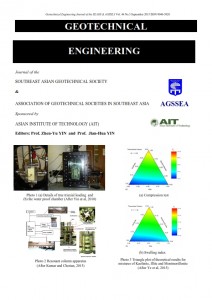Soil Deformation Induced by Underground Tunnel Construction
Main Article Content
Abstract
Development and utilization of underground railways can effectively ease the problem of urban traffic congestion. However, surrounding soil disturbance during tunnel excavation is likely to cause serious accidents. Thus, analyzing soil deformation during tunnel excavation is important. Through numerical simulation, this paper analyzes the influence of the step distance of a single-bore tunnel on the disturbance of the surrounding soil. Based on research on a single-bore tunnel, this paper further examines the effects of various spacing, locations, and excavation methods on the deformation of surrounding soils during parallel tunnel excavation. The results show that longer excavation steps lead to more intense disturbance to the surrounding soils. The most intense disturbance occurs at the ends of the tunnel. During new tunnel excavation, the tunnel crossing angle has stronger influence than the tunnel spacing on the original tunnel. Among the four excavation methods, single-bore advanced through is the most secure, whereas simultaneous excavation from opposite directions can cause the most intense disturbance to the surrounding soils. In practical operations, corresponding excavation methods can be employed according to specific conditions. Moreover, in-situ monitoring at key positions should be enhanced to avoid accidents.
Article Details

This work is licensed under a Creative Commons Attribution-NonCommercial-NoDerivatives 4.0 International License.
Copyright © 2019 Association of Geotechnical Societies in Southeast Asia (AGSSEA) - Southeast Asian Geotechnical Society (SEAGS).


